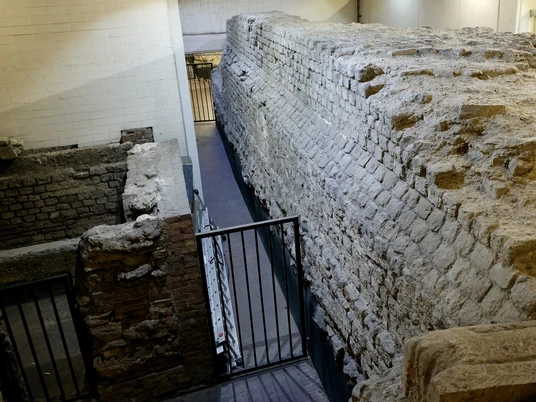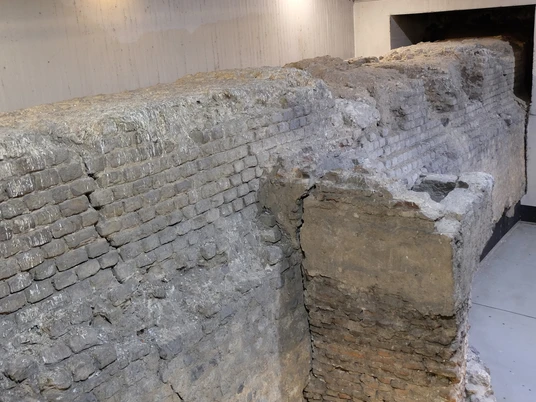- Photos & Map
How would you like to arrive?
- Details
- Useful Information
- Nearby
Numerous ancient testimonies to Cologne's 2000-year history can be found in the city's museums or in the cityscape itself. Some of them are in curious places that at first glance do not appear to produce any special features.
The underground car park under Cologne Cathedral Square conceals remains of the Roman city wall that bear witness to Cologne's elevation as a city. The entrance is at a small side entrance on the corner of Komödienstraße/Trankgasse opposite the Tourist Information Cologne.
The remains of Cologne's ancient wall go directly hand in hand with its elevation to the status of a city under Roman law. As the Roman historian Tacitus wrote, the "Oppidum Ubiorum" (the city of the Ubians) was raised to the status of Colonia Claudia Ara Agrippinensium in 50 AD at the instigation of Agrippina, the wife of the emperor of the time. In this context, a city wall was built for defence and representation purposes. Not only did the city and its wall secure the border of the Roman Empire, it also represented the mother city of Rome as its small image.
In addition to the section of the Roman city wall, two other elements are visible in the underground car park. A Roman cellar is placed in the entrance area, which was found when the underground car park was built. The cellar was part of the Roman residential development that shaped today's cathedral surroundings in antiquity. As it would have been in the way of the underground car park's traffic, the cellar was moved to its present location.
In an easterly direction, beyond the underground car park exit, there is also a shaft that was added to the Roman city wall in the Middle Ages. The shaft is commonly referred to as the Annoloch or Annostollen, which the then Archbishop Anno II is said to have used to escape in 1074. A conflict with the citizens of Cologne led to a revolt against the archbishop, forcing him to flee the city in haste. The archbishop was able to flee via the annexe and have the uprising put down by his knights from their exile in Neuss.
The underground car park under Cologne Cathedral Square conceals remains of the Roman city wall that bear witness to Cologne's elevation as a city. The entrance is at a small side entrance on the corner of Komödienstraße/Trankgasse opposite the Tourist Information Cologne.
The remains of Cologne's ancient wall go directly hand in hand with its elevation to the status of a city under Roman law. As the Roman historian Tacitus wrote, the "Oppidum Ubiorum" (the city of the Ubians) was raised to the status of Colonia Claudia Ara Agrippinensium in 50 AD at the instigation of Agrippina, the wife of the emperor of the time. In this context, a city wall was built for defence and representation purposes. Not only did the city and its wall secure the border of the Roman Empire, it also represented the mother city of Rome as its small image.
In addition to the section of the Roman city wall, two other elements are visible in the underground car park. A Roman cellar is placed in the entrance area, which was found when the underground car park was built. The cellar was part of the Roman residential development that shaped today's cathedral surroundings in antiquity. As it would have been in the way of the underground car park's traffic, the cellar was moved to its present location.
In an easterly direction, beyond the underground car park exit, there is also a shaft that was added to the Roman city wall in the Middle Ages. The shaft is commonly referred to as the Annoloch or Annostollen, which the then Archbishop Anno II is said to have used to escape in 1074. A conflict with the citizens of Cologne led to a revolt against the archbishop, forcing him to flee the city in haste. The archbishop was able to flee via the annexe and have the uprising put down by his knights from their exile in Neuss.
Useful Information
Eligibility
Bad Weather Offer
Suitable for any weather
for Groups
for Class
for families
for individual guests
Suitable for the Elderly
Parking facilities
The wall section and the underground car park are under the Cathedrals pedestal in the centre of the city. The main railway station is therefore in the immediate vicinity. Visitors are best advised to use the side entrance to the underground car park at the junction of Komödienstraße / Trankgasse / Kardinal-Höffner-Platz.
Nearby

